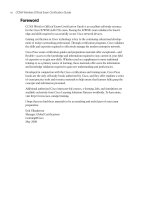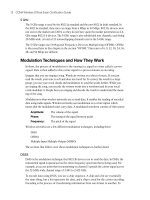CCNA Wireless Official Exam Certification Guide part 46 doc
Bạn đang xem bản rút gọn của tài liệu. Xem và tải ngay bản đầy đủ của tài liệu tại đây (367.51 KB, 10 trang )
422 CCNA Wireless Official Exam Certification Guide
Using Tech Support
You might also find the Tech Support Pages, found at MANAGEMENT > Tech Support,
to be of benefit. Although Cisco TAC uses most of what you do here, you might find it
beneficial information for troubleshooting.
Crash logs, which the controller maintains, are created when a system fails. You cannot
use most of the information found in the logs without Cisco TAC assistance. If Cisco TAC
request these logs, you can access them by going to MANAGEMENT > Tech Support >
Controller Crash. Five crash dump files can be stored on a controller at any given time.
APs also create a crash log file that the controller can download. Go to MANAGEMENT
> Tech Support >AP Crash Log > Get Log to retrieve it. TAC also uses the AP crash logs.
Figure 20-5 SNMP Trap Logs
23_1587202115_ch20.qxp 9/29/08 2:43 PM Page 422
Chapter 20: Troubleshooting Wireless Networks 423
Using WCS Version 5.x to Troubleshoot Clients
You can use WCS to troubleshoot wireless deployments. Use the Monitor > Client page
to troubleshoot clients. You can see this page in Figure 20-6. When you use this tool, you
get a Summary page with a list of problems and corresponding solutions. The page also
has a log analysis and a detailed event history.
You can use the alarms to troubleshoot. In the Clients Summary page, click the numerous
alarms in the lower left to be taken to that Alarm page. Figure 20-6 shows several critical
alarms.
Using the Cisco Spectrum Expert
Cisco Spectrum Expert addresses the problem of RF interference in wireless networks.
With Cisco Spectrum Expert, you can detect, classify, locate, and manually mitigate
sources of wireless interference.
The Cisco Spectrum Expert Wi-Fi is the industry-leading spectrum intelligence product
for Wi-Fi networks. Cisco Spectrum Expert Wi-Fi offers complete visibility into the RF
physical layer in the 2.4-GHz and 5-GHz frequencies, allowing for enhanced performance,
security, and reliability of WLAN services.
Figure 20-6 Critical Alarms
23_1587202115_ch20.qxp 9/29/08 2:43 PM Page 423
424 CCNA Wireless Official Exam Certification Guide
The Cisco Spectrum Expert Wi-Fi includes the following components:
■ Cisco Spectrum Expert Wi-Fi sensor
■ Cisco Spectrum Expert software
■ Cisco Spectrum Expert antenna
The Cisco Spectrum Expert Wi-Fi sensor is a sensor in the CardBus card form factor for
notebooks. It is supported on Microsoft Windows–based laptops and delivers compre-
hensive spectrum intelligence. Network administrators can streamline wireless network
troubleshooting with better visibility into the RF spectrum and can easily identify and de-
tect sources of wireless interference.
Cisco Spectrum Expert provides a comprehensive list of all access points, ad hoc net-
works, and interferer devices (for example, microwave ovens, cordless phones, wireless se-
curity cameras, Bluetooth devices, and RF jammers).
Cisco Spectrum Expert also gives you a Channel Summary that provides visibility of RF
activity—such as power levels and presence of 802.11 and interferer devices—on a channel-
by-channel basis.
The Devices View provides a deeper look at each device and its impact to the wireless net-
work, including power level, channel coverage, and other data.
A Device Finder tracks down the location of devices, causing wireless interference
throughout your enterprise. The Device Classifier offers the most comprehensive classifi-
cation of the RF devices, which include the following:
■ Wi-Fi access points
■ In-network devices
■ Known devices
■ Unknown devices
■ Ad hoc devices
■ Wi-Fi stations
■ A variety of Bluetooth devices
■ A variety of cordless phones
1
■ Microwave ovens
■ Generic fixed-frequency devices
■ Generic frequency-hopped devices
■ Generic continuous transmitters (for example, FM phones, NTSC video devices)
■ RF jamming devices
■ 802.11FH devices
■ Analog video devices
23_1587202115_ch20.qxp 9/29/08 2:43 PM Page 424
Chapter 20: Troubleshooting Wireless Networks 425
The Spectrum Views create plots and charts for a direct view into the RF spectrum, includ-
ing measurements of RF power and network device activity. The plots are especially useful
to trained RF engineers, and the charts are informative for both the expert RF engineer and
the generalist network engineer.
An Alarms Setting configures enterprise-specific alerts and alarm triggers to notify you
when wireless network is at critical utilization points.
All this is integrated with Cisco WCS and is based on obtaining a license to integrate it.
23_1587202115_ch20.qxp 9/29/08 2:43 PM Page 425
426 CCNA Wireless Official Exam Certification Guide
Exam Preparation Tasks
Review All the Key Topics
Review the most important topics from this chapter, noted with the Key Topics icon in the
outer margin of the page. Table 20-3 lists a reference of these key topics and the page
number where you can find each one.
Complete the Tables and Lists from Memory
Print a copy of Appendix B, “Memory Tables,” (found on the CD) or at least the section
for this chapter, and complete the tables and lists from memory. Appendix C, “Memory
Tables Answer Key,” also on the CD, includes completed tables and lists to check your
work.
Table 20-3 Key Topics for Chapter 20
Key Topic Item Description Page Number
Paragraph from the section
“Common Client-Side Issues”
Discussion of the Hidden Node
issue
410
Paragraph from the section
“Common Client-Side Issues”
Discussion of the Exposed
Node issue
410
Paragraph from the section
“Common Client-Side Issues”
Discussion of the Near/Far issue 410
Example 20-1 Viewing the client summary 411
Example 20-2 Viewing client details 411
Command syntax Enable client troubleshooting 414
Command syntax Debug LWAPP events 414
Example 20-4 Verify enabled debugs 414
Figure 20-1 Viewing the client summary 417
Figure 20-2 Viewing the controller logs 418
23_1587202115_ch20.qxp 9/29/08 2:43 PM Page 426
Chapter 20: Troubleshooting Wireless Networks 427
Definition of Key Terms
Define the following key terms from this chapter, and check your answers in the Glossary:
Hidden Node issue, Exposed Node issue
References
“Troubleshooting TechNotes” at Cisco.com: />“Troubleshooting Connectivity in a Wireless LAN Network” at Cisco.com: http://tinyurl.
com/6l2ob2
The Cisco Spectrum Expert at Cisco.com: />23_1587202115_ch20.qxp 9/29/08 2:43 PM Page 427
24_1587202115_part4.qxd 9/29/08 2:46 PM Page 428
Chapter 21 Final Preparation
Part IV: Final Preparation
24_1587202115_part4.qxd 9/29/08 2:46 PM Page 429
25_1587202115_ch21.qxp 9/29/08 2:39 PM Page 430
CHAPTER 21
Final Preparation
This book has covered the technologies, protocols, commands, and features required for
you to be prepared to pass the CCNA Wireless exam. Although this book supplies de-
tailed information, most people need more preparation than simply reading a book. This
chapter details a set of tools and a study plan that can help you complete your preparation
for the exam.
If you’re preparing for the CCNA Wireless exam, you should have already passed the CCNA
level exams, either the CCNA exam or the ICND1 and ICND2 exams. For information on
passing the CCNA exams, refer to
CCENT/CCNA ICND1 Official Exam Certification Guide
or
CCNA ICND2 Official Exam Certification Guide
, or go to />This short chapter has two main sections. The first lists the exam preparation tools that are
useful at this point in your study process. The second section lists a suggested study plan
now that you have completed the rest of the chapters.
Note: This chapter refers to many of the chapters and appendixes included with this
book, as well as tools available on the CD. Appendixes B and C are included only on the CD
that comes with this book. To access those, just insert the CD and make the appropriate se-
lection from the opening interface.
Tools for Final Preparation
This section describes the available tools and how to access them.
Exam Engine and Questions on the CD
The CD in the back of the book includes an exam engine—software that displays and
grades a set of exam-realistic questions. The question database includes simulation (sim)
questions, drag-and-drop questions, and many scenario-based questions that require the
same level of analysis as the questions on the CCNA Wireless exam. Using the exam en-
gine, you can either study by practicing using the questions in Study Mode, or take a sim-
ulated (timed) CCNA Wireless exam.
The installation process has two major steps. The CD in the back of this book has a recent
copy of the exam engine software, supplied by Boson Software ().
The practice exam—the database of CCNA Wireless exam questions—is not on the CD.
Instead, the practice exam resides on the www.boson.com web server, so the second ma-
jor step is to activate and download the practice exam.
25_1587202115_ch21.qxp 9/29/08 2:39 PM Page 431









